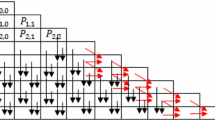Abstract
This research represents a continuation of the investigation carried out in the paper of Petrovskaya and Vershkov (J Geod 84(3):165–178, 2010) where conventional spherical harmonic series are constructed for arbitrary order derivatives of the Earth gravitational potential in the terrestrial reference frame. The problem of converting the potential derivatives of the first and second orders into geopotential models is studied. Two kinds of basic equations for solving this problem are derived. The equations of the first kind represent new non-singular non-orthogonal series for the geopotential derivatives, which are constructed by means of transforming the intermediate expressions for these derivatives from the above-mentioned paper. In contrast to the spherical harmonic expansions, these alternative series directly depend on the geopotential coefficients \({\bar{{C}}_{n,m}}\) and \({\bar{{S}}_{n,m}}\). Each term of the series for the first-order derivatives is represented by a sum of these coefficients, which are multiplied by linear combinations of at most two spherical harmonics. For the second-order derivatives, the geopotential coefficients are multiplied by linear combinations of at most three spherical harmonics. As compared to existing non-singular expressions for the geopotential derivatives, the new expressions have a more simple structure. They depend only on the conventional spherical harmonics and do not depend on the first- and second-order derivatives of the associated Legendre functions. The basic equations of the second kind are inferred from the linear equations, constructed in the cited paper, which express the coefficients of the spherical harmonic series for the first- and second-order derivatives in terms of the geopotential coefficients. These equations are converted into recurrent relations from which the coefficients \({\bar{{C}}_{n,m}}\) and \({\bar{{S}}_{n,m}}\) are determined on the basis of the spherical harmonic coefficients of each derivative. The latter coefficients can be estimated from the values of the geopotential derivatives by the quadrature formulas or the least-squares approach. The new expressions of two kinds can be applied for spherical harmonic synthesis and analysis. In particular, they might be incorporated in geopotential modeling on the basis of the orbit data from the CHAMP, GRACE and GOCE missions, and the gradiometry data from the GOCE mission.
Similar content being viewed by others
References
Balmino G, Barriot J-P, Valès N (1990) Non-singular formulation of the gravity vector and gravity gradient tensor in spherical harmonics. Manucsr Geod 15(1): 11–16
Cunningham L (1970) On the computation of the spherical harmonic terms needed during the numerical integration of the orbital motion of an artificial satellite. Celest Mech 2: 207–216
Ditmar P, van Eck van der Sluijs AA (2004) A technique for modeling the Earth’s gravity field on the basis of satellite accelerations. J Geod 78(1–2): 12–33
Ditmar P, Kuznetsov V, van Eck van der Sluijs AA, Schrama E, Klees R (2006) ‘DEOS_CHAMP-01C_70’: a model of the Earth’s gravity field computed from accelerations of the CHAMP satellite. J Geod 79(10–11): 586–601
Eshagh M, Abdollahzadeh M, Najafi-Alamdari M (2009) Simplification of geopotential perturbing action on a satellite. Artif Satell 43(2): 45–64
Eshagh M (2010) Optimal combination of integral solutions of gradiometric boundary value problem using variance components estimation in the Earth gravitational modeling. Earth Planets Space 62: 1–12
Fantino E, Casotto S (2009) Methods of harmonic synthesis for global geopotential models and their first-, second- and third-order gradients. J Geod 83(7): 595–619
Lemoine FG, Kenyon SC, Factor JK, Trimmer RG, Pavlis NK, Chinn DS, Cox CM, Klosko SM, Luthcke SB, Torrence MH, Wang YM, Williamson RG, Pavlis EC, Rapp RH, Olson TR (1998) Geopotential model EGM96. NASA/TP-1998-206861. Goddard Space Flight Center, Greenbelt
Liu X (2008) Global gravity field recovery from satellite-to-satellite tracking data with the acceleration approach. In: Netherlands Geodetic Commission, Publications on Geodesy, vol 68. Delft, The Netherlands
Pavlis NK, Holmes SA, Kenyon SC, Factor JK (2008) An Earth Gravitational Model to Degree 2160: EGM2008 (2008), presented at the 2008 General Assembly of the European Geosciences Union. Vienna, Austria, 13–18 April 2008
Petrovskaya MS, Vershkov AN (2006) Non-singular expressions for the gravity gradients in the local north-oriented and orbital reference frames. J Geod 80(3): 117–127
Petrovskaya MS, Vershkov AN (2010) Construction of spherical harmonic series for the potential derivatives of arbitrary order in the geocentric Earth-fixed reference frame. J Geod 84(3): 165–178
Pines S (1973) Uniform representation of the gravitational potential and its derivatives. AIAAJ 11: 1508–1511
Reubelt T, Austen G, Grafarend EW (2003) Harmonic analysis of the Earth’s gravitational field by means of semi-continuous ephemerides of a low Earth orbiting GPS-tracked satellite. Case study Champ J Geod 77(5–6): 257–278
Reubelt T, Götzelmann M, Grafarend EW (2006) Harmonic analysis of the Earth’s gravitational field from kinematic CHAMP orbits based on the numerically derived satellite accelerations. In: Flury J (Ed.) Observation of the Earth System from Space. Springer, Berlin, Heidelberg. doi:10.100713/3-540-29522-4
Rummel R, Sansò F, van Gelderen M, Koop R, Schrama E, Brovelli M, Migliaccio F, Sacerdote F (1993) Spherical harmonic analysis of satellite gradiometry. In: Publ Geodesy, New Series, No. 39. Netherlands Geodetic Commission, Delft
Author information
Authors and Affiliations
Corresponding author
Rights and permissions
About this article
Cite this article
Petrovskaya, M.S., Vershkov, A.N. Basic equations for constructing geopotential models from the gravitational potential derivatives of the first and second orders in the terrestrial reference frame. J Geod 86, 521–530 (2012). https://doi.org/10.1007/s00190-011-0535-2
Received:
Accepted:
Published:
Issue Date:
DOI: https://doi.org/10.1007/s00190-011-0535-2




